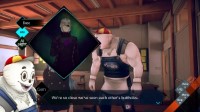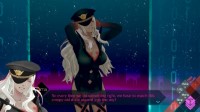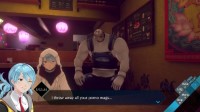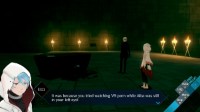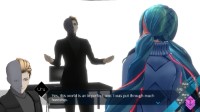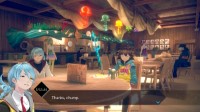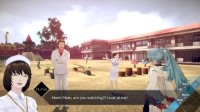AI: NirvanA Initiative
Playtime: 41.8 Hours
Finished 19 January 2023.Finished all main and side routes of the game. Didn't quite get every ending - I think I'm missing one where Ryuki shoots Date by Tearer's command, I refused at that part. Or maybe there's another secret ending I didn't find (I got the Atami one of course). Collected most, but not all of the appendix and trivia entries; ended at Psyncer rank S3 (S1 is the max). I don't really have the interest in doing all of the little things to get the rest of the stars at the moment, that's just busywork at this point. Gathered most of the Eyeball-ies (Tamagotchi thing), and almost none of the hidden eyeballs in the Somnium stages. I ended up with close to ~15k eyeballs total, but didn't spend it on much in the bonus menu yet since the unlocks can only be used on stages you've already beaten.
By the way, Tokiko's hologram in the epilogue had a NIL #711016. Based on the early checks in this game for spoilers from AI 1, this code will probably be used in the third game?
I really, really liked this game. I wouldn't quite put it at the level of the first, but it's a very close call for me based more on my personal preferences, and less on issues with the game. Firstly, the returning cast from the first AI is as good as ever, though most of them don't have a major presence this time (with the exception of Mizuki, Aiba, and Date). I still don't like Ota though, I feel like his character just gets less likable over time. I almost wish he was properly killed off in the first game. As for the characters new to AI 2 - I really liked most of them, but there were definitely a number of strange story pacing and plotline focus issues in this game.
One example is the relationship between Lien and Kizuna, which is a very major side plot that doesn't really need to exist in the form that it does. Every major turning point of their relationship takes place directly on screen, which makes them feel like arbitrarily-added roadblocks to make the game longer. There are constant (external) relationship issues to the point where it gets old, each of require lots of extra tasks to do in game that distract from the main murder plot. There are MULTIPLE Somnium stages dedicated entirely to these issues! Individually, Lien is pretty much always used simply as an arbitrary tool for accessing areas (unless he's moping about Kizuna), and Kizuna herself is pretty much useless except she gets kidnapped twice and disabled halfway through the game, making her essentially the token victim. They've got much deeper ties to the story and other major characters, but those aren't explored enough because all of the focus goes into treading the same relationship issues over and over again. I'd find their development together very sweet if it wasn't such an annoying distraction. Note that the scene where they finally get together (the first time, before they split again to drag out the plot even more) takes place in the middle of Mizuki looking for leads to a murder. It's such a whiplash.
On the opposite side of the scale is the relationship between Amame and Gen. The relationship between these two characters is almost completely static the entire game, since the characters feel simiarly flat development-wise. Like Lien's attitude towards Kizuna, Gen's personality usually boils down to his desire to protect Amame, and also being a very large, imposing character. Meanwhile, Amame spends about 90% of the game pretty much just moping about and refusing to interact with anything. This simultaneously makes it feel like she's very underused, while also making it obvious that she's an incredibly suspicious character; why would she have such a prominent role if she's pointless to the plot the entire way through? Her big appearance at the end of the game ends up being a completely expected and predictable result, but because so little depth was put behind her character throughout the first 40 hours of the game, it rings completely hollow. It's hard to share in her grief when the game never gave you any chance to learn what her character is like normally. Unlike Kizuna & Lien, at least Amame & Gen are plot relevant - but in general, they are such static entities that they don't really feel like part of the flow of the story.
They've doubled the main characters in this game, having Mizuki + Aiba replace Date, and adding in Ryuki + Tama as a second investigator pair for the first half of the game. I really like Mizuki as a playable character in this game - there are a lot more opportunities for her to show her supernatural abilities and her mildly snarky personality shines during the investigations, especially as she's mellowed out a little bit with age. The older Mizuki continues that trend too, and the two Mizuki's have a great dynamic for the short span of time they're together in the game. Aiba is back and as great as ever, with every bit of personality she had in the first game, making for an extremely enjoyable character dynamic at all times. On the other hand, I don't particularly like Ryuki - it feels like he was almost designed by committee since he's such a generic goody anime boy with sad backstory. I was hoping for a twist or at least some depth of some kind but never got any, which makes him feel like a side character almost, even though you spend 20 hours investigating as him. Thankfully, Tama is a far more interesting character (not just the boobs, I swear) and is able to add more life to Ryuki's sections, drawing out aspects of his personality and interests to lend at least a bit of substance to an otherwise design-for-trope character. The chemistry developed between Ryuki and Tama makes his half of the game significantly better than it would have been otherwise.
Outside of the main player-side group of characters, I've got some issues with the conspirator characters. Horadori, for example, is an incredibly annoying character. He's got some of the worst expressions in the game and they won't stop shoving him into the game every time they can. To be fair, there's no real room to put him in a future game, but I didn't want that much of him in this one either. Also, they keep bringing up his membership to the Order of % but that entire concept is pretty much useless except to set up a couple of randomly pivotal details, which could have been explained better through other means. Sometimes the game just forgets things like that, which are supposedly central to the plot and yet have no real relevance. As another example, Ryuki learns that Tearer's name is 'Dahlia Boat', but that is not used outside of it being a password unlock for Mizuki's story.
At a larger scale, the side endings completely abandoning the mystery is strange and invites more trouble than it's worth. They just end the game randomly after a regular scene (Komeji's is probably the best of the side endings), and there's no reasonable explanation for the handling of this since timeline memory is not a mechanic that is introduced in these games. Most other VNs have separate routes play through completely different scenarios, but still resolve the main story in varying ways. As another example, G-Senjou no Maou also "abandons" the plot for the side endings, but they all imply that Maou was the main character's alter ego. In Haru's route, the true culprit is revealed, but it's a really cool trick used in that game to allow for side stories cutting off the main plot, which is simply not handled at all in Nirvana Initiative. Even 999 and the Nonary Games are founded on a key concept of being able to communicate between timelines, which this game tried using too without the mechanical or logical consistency built into the world.
My final issues with the conspirator plot in this game revolve around their actions towards the true end of the game (and purpose of the Nirvana Initiative), which felt incredibly hollow and ultimately made the game fall a bit flat nearing the finish line. Lots of details feel strange - how does a serial murder case suddenly turn into a bio-warfare threat, with seemingly no link in between other than the perpetrators? The killings were not motivated nor affected by TC-PERGE, yet suddenly at the 11th hour the entire plot shifts to stopping a warhead launch at all costs. If the TC-PERGE plot was truly the end goal, this game would have significantly benefited from more murders caused by TC-PERGE victims killing people, either blindly or in a programmed, targeted manner. Instead, the random killings only drew attention to the plot, which is beyond stupid from a writing perspective. Also, the fact that all of the evil groups came together and somehow had prerecorded video from Tearer (Uru) and Tokiko announcing how smart they are just nails the ending into an airtight coffin. The entire ending action sequence of the game felt unnecessarily flashy and tacked on, and the completely divergent murder and TC-PERGE plots remind me of Spiderman 3 starring both Sandman and Venom, with the overall product coming out worse as a result. A single high-tension moment at the end disposing of the villain and not wasting time waffling around with fancy punches and ensemble shots is the way to go. You can still have the dance party at the end anyway.
The way that this game handled atmosphere and emotions is generally inferior to the first game, with a major factor being that there are only 5 actual murders, and 4 of them are for characters that nobody cares about or likes. (Side note: Unlike AI1, I actually very much appreciate that the murdered characters are actually permanently dead, and not magically resurrected in the other/true timeline.) A contributing factor to AI1's creepy atmosphere was this perception of constant betrayal. Different routes represent many different characters as the murderer or the murdered (because of the soul-swap) - it always makes you question the truth behind Boss, Iris, and other characters that seemingly have blood on their hands. This added a ton of ambient tension that is completely absent from AI2. In AI2, not only is incredibly obvious who's about to die, but I also didn't care about any of them at all other than Komeji. The murders and victims don't feel close, and there's no sense of a looming threats approaching or even within ABIS, in stark contrast to AI1 (Pewter...). Even in the true ending path, learning that there is a second murderer isn't really a concern beyond more puzzle-solving. There's no immediate feeling of fear when they're just killing people that I didn't like anyway. As a result of this, the game leans HARD on Komeji's death, and uses it as an anchor for the rest of the game. Amame's motivations for killing Tearer, Shoma's sadness, and all the compounding issues in the second duo of murders all stem from this event. Even when talking to most of the characters about the other deaths, none of them seem particularly shaken by any of the other deaths, aside from Komeji. This forced the writers to add this world domination plot to try getting some momentum back for the story, kicking Mizuki into action to stop the new threat but muddling the scope of the plot significantly. Overall, the first game felt very personal, small in scale, and ultimately more dangerous than AI2, which is missing some of that substance.
I feel like this game was primarily designed to trick the player, and not the characters. Most of the twists don't work if the game isn't played in chronological order - that's why the game deliberately fudged the timelines. But this means that the player characters in the game aren't actually confused by most of the things the player is confused by, so the game just feels very poorly written for the first 80% of the time spent. Even after the reveal, you notice some inconsistencies - characters that are in the wrong outfit at the wrong time, etc. It also voids the mysterious feel quite a bit, knowing that the characters didn't share any of the same concerns. Also, I should mention that it made the "two of them" solution for Jin/Uru and Mizuki/Mizuki very likely long before the reveal. So much of the writing is braced right up against the 4th wall, but it feels like a clumsy attempt at balancing dialogue aimed at the player with dialogue within the world, which doesn't work. A major component of this is that most characters look the exact same before and after a 6-year timeskip, which I also noticed very early on. Most characters are relatively young, yet only Mizuki (both), Kizuna, Iris, Ota, and a few others look any different. Again, this is a detail intended to trick the player, while sacrificing the integrity of the world and realism of the characters. Why would Amame look the exact same after 6 years? She's gone from high school to young adult! If the game had used a smaller time skip, this could have been more believable - but then, the 2 Mizukis reveal wouldn't have worked. It's a lose-lose either way, since it doesn't really work well regardless.
To briefly return to the mention of balancing at-player dialogue with at-character dialogue, this game has a ton of very preachy dialogue, especially towards the end of the game. Several situations where characters will rattle on for minutes about how great their friends are, or how much they've grown as a person and they'll never back down from their true self, and other similar platitudes. These very frequently take place during combat too - if I actually played out the scenes, they could be up to 1-2 minutes long of a character just standing in a middle of a bunch of dudes talking about random shit. There's a scene in the epilogue where Mizuki talks about supporting LGBTQ+, the disabled, minorities, and other people who tend to be oppressed for something like 2-3 minutes. It's a great message but it's done in such an awkward and artificial tone, which is a complete break from her character. Also note that she's in a bar, talking to a guy (Mamoru) who just lost his security guard job, is very drunk and is definitely not listening. Surely there could be far better ways to integrate all of these sentiments (for all the above awkward dialogues) throughout the game, rather than simply dumping them in at the end? Instead of monologuing about the power of friendship, showing scenes where each character has a chance to show off their unique skills as they work together would demonstrate everything that needn't be said instead. People don't need to announce these things for them to be true.
Visually, this game is basically the same as the first. It looks great stylistically but with the same performance issues - it's awfully laggy when playing in the Switch's portable mode. It works quite a bit better when docked, and smooth most of the time unless there are a lot of effects or characters on screen. There are a lot of new character designs in this game, or redesigns of characters from the first due to the passage of time (causing some problems, as mentioned earlier). I particularly like Mizuki and older-Mizuki's designs a lot - as she gets older, she gets cuter. I also like the fact that a few characters have very strangely-shaped proportions for no reason. Komeji having a cube head (and skull) was pretty funny the entire game, as was Horadori's cylinder head. The weird psychedelic videos were clearly a lot of fun to make; one of the developers had a lot of fun using ALICE or something similar to make extremely low-quality weird videos using a random stock assets for sure. Outside of some of the codes present in Bats490 and Nirvana X, I'm pretty sure they just fooled around with random effects until they got something that was incomprehensible enough to use. As a somewhat-related side note though, I noticed that the mini-transitions into and out of the Somniums looked really compressed and had tons of audio stuttering which I don't think is intended. I wonder what happened? I'm pretty sure those looked fine in the first game.
Finally, to go over some aspects of the game's mechanics. The Somnium stages pretty much work the same way that they did in the first game, which is unfortunate since I didn't really like how they were designed. It's worth noting that most of these complaints are eliminated by lowering the difficulty for these sections to grant more time and resets, which is a nice option added to this game. Still, the "standard" experience has a number of fundamental issues that I don't quite like. The timing of each action feels completely arbitrary; often times, there will be random events that suck up ridiculous amounts of time, or a ton of sequential events that cost very little. These are not based on any kind of logic or consistency (pushing giant crates can take ~10 sec, but sometimes reading a book will take 180 sec...), so you can't really plan the time you spend in one of the puzzles. This applies at a larger scale to the mental locks too, since some of them can be as simple as a single question (like in the last Somnium), while others may contain multiple massive puzzles. On top of the inconsistent timing, you have a limited number of resets, and each reset can only take you back to the previous checkpoint. As a result, the game heavily encourages fully resetting, because getting mildly stuck at each section of a stage can easily make the rest of the Somnium entirely impossible to complete. Better to start from the beginning and just fast-forward your way to where you were, which is just an additional waste of time with no value. This could be slightly mitigated by allowing the use of TIMIEs on inspect prompts (not currently possible), since there are a lot more of those compared to AI 1. But the system needs to be completely reworked overall - mechanically, the Somniums are just not well designed. As a sidenote, the collectible eyeballs seem to be glitched; I never got them to consistently work, whether I tried mashing A near them or simply walking through them.
Other parts of the gameplay generally fare better. The investigations haven't changed, but they were perfectly fine to begin with. The action scenes feel significantly toned up in this game though, probably because Mizuki is a far more combat-capable character than Date. The QTEs are fine, but I've got mixed feelings about the action scenes themselves, which don't feel dangerous whatsoever. Every one of them consists of a bunch of random faceless goons that the characters sweep around like in a musou game, alongside tons of stupid mid-action dialogue scenes, dumb posing, and weird shot angles that are meant to look cool but end up looking lame. I'd really hope any further games in the series focus on higher tension scenes with fewer random mobs, since those encounters always felt more dangerous. Outside of the combat, the new VR Investigaton mechanic is really cool - I like how it gives a more formalized way to look at a crime scene with more depth and figure out what happened, complete with recreations about how each of those scenes could plausibly happen, instead of having to try imagining it mentally. I hope these are expanded on significantly in the future; I really enjoyed the ones that were in this game, but felt that they were too short and too few in number. Also, I liked how the passwords were used to gate off most of the routes, as it forces the player to actually pay attention instead of just holding A or ZR. I'm a little annoyed that they didn't do that for the true ending. It would be really neat to see more passwords for future entries, potentially to gate off secret endings or even the true end - allowing someone who's figured out the mystery to test their deductions without having to arbitrarily sidetrack for a few hours first.
